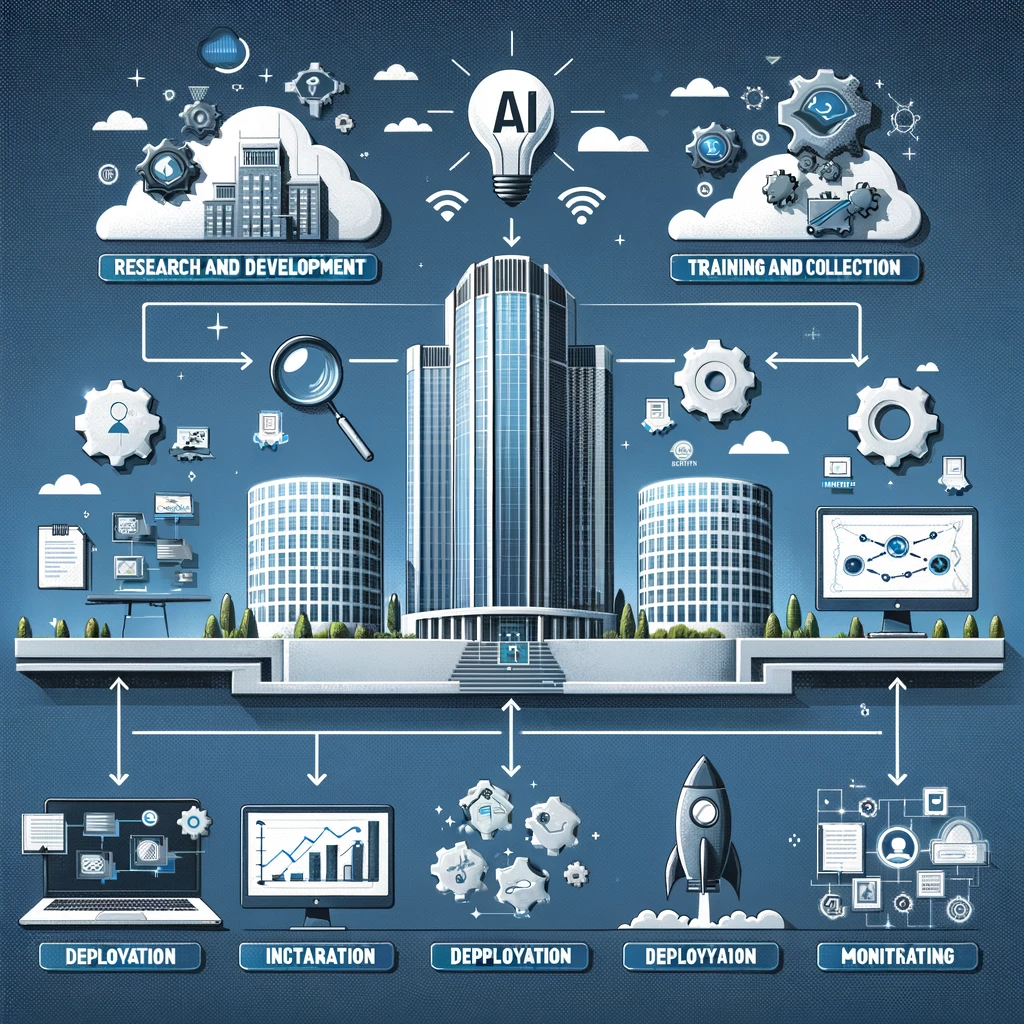We are currently witnessing a technological revolution that is reshaping many industries, bringing with it previously unimaginable possibilities. At the forefront of these changes is artificial intelligence.
However, harnessing its potential in a company is not a simple task.
From this post, you will learn step by step how to implement AI-based solutions in your organization.
Is AI just ChatGPT?
Let’s start by debunking a myth. Many people think that artificial intelligence is just ChatGPT or perhaps other models for generating text or graphics.
In reality, AI existed long before these tools. They are just examples of generative AI, a subset of artificial intelligence. It involves generating certain content by the model, such as text, graphics, sound, or video.
However, we must remember that there are other families of AI models, such as predictive or optimization models, which work completely differently. Their task is to predict different values, not generate content.
Choosing the right model should be based on the needs of your company and the processes you need to streamline.
What does AI implementation involve?
So, is it enough to properly identify the area and then look for ready-made AI tools on the market?
Unfortunately not. Firstly, because AI has been rapidly evolving only recently, and secondly – due to the large diversity of companies’ needs – there are no high-quality ready-made products for most applications.
Usually, AI implementation involves designing and implementing tailor-made software by qualified specialists.
It’s a multi-stage process that allows managing risks at every stage and ensuring maximum return on investment.
1.Understanding Needs and Identifying Areas
In the first stage, we need to understand what needs our company has that can be improved with AI. It’s about identifying inefficient processes or daily problems. It’s worth looking broadly here, not limiting ourselves to one department or area.
Then we need to determine if the identified problems can be solved by AI. Simple automation (e.g., a script copying files) is often mistaken for an AI-based system. Therefore, at this stage, a team of people with various specializations is needed – both business sector representatives, AI specialists, as well as user interface engineers, or even lawyers.
Examples of Problems Most Often Solved by AI:
A. Repetitive, tedious human work
This could be, for example, gathering information from email orders, creating similar documents, or asking customers repetitive questions.
Solutions here include text analysis systems, chatbots, or vector databases and RAGs.
B. Complex tasks (too many variables)
This problem occurs in aspects such as production planning, warehouse management, or predicting machine failures.
To solve this, agent systems, digital twins, or so-called classical machine learning – models trained on tabular data – are used.
C. Untapped potential in accumulated data
It’s often the case that companies have been collecting data about customers or products for many years. Utilizing the knowledge contained in them allows for significant increase in sales or reduction in losses, through personalized customer experience or trend prediction.
Predictive and optimization algorithms trained on historical data are used for this. Solutions may include recommending systems, such as products or discounts for customers.
2.Defining Goals and Strategies
Once we have a preliminary idea for an algorithm, we need to determine if the solution is worth it at all. Business KPIs need to be compared with the expected effectiveness of the algorithm.
Contrary to what is often repeated in the media about AI, algorithms very rarely completely replace human work. They usually require control and do not allow achieving one hundred percent effectiveness.
Their improvement can be time-consuming, so at the outset, we need to determine the effectiveness of the algorithm we expect and how it will translate into business goals. We also need to define a metric, an objective measure that will allow us to recognize whether the algorithm is performing as expected.
How to determine the right metric? It could be, for example, the percentage of correct answers, the percentage of detected errors, or the average difference in price prediction compared to human valuation.
However, it is important to note that the effectiveness metric is not the only limitation, as there may be time requirements for the algorithm (especially if it needs to work in real-time, e.g., on a website), or implementation costs.
3.Prototyping / Proof-of-concept development
Developing AI algorithms is always a research and development activity. Until we analyze the data and train the first models, it’s hard to predict their effectiveness.
Therefore, to limit risk and costs in the project, it’s always worth starting implementation with prototyping. It could be a simple algorithm instead of a complicated one, or a system operating on a data sample.
This stage allows us to test our hypothesis with low costs, review the assumed KPIs, and also estimate the entire project accurately. From our experience (as well as existing reports), about 80% of Proof-of-concept stages lead to further work.
4.Data analysis and model approach selection
Depending on the amount of data we have and the expected results, three levels of AI model building are possible.
I) Using an existing architecture
In this approach, we use models trained on large data corpora, such as text, so-called foundational models. They are divided into closed models (e.g., GPT4, Gemini), whose code is not available, and open-source models (e.g., LLaMA), whose code is available and can be run on local infrastructure, providing a high level of data protection.
In this case, we only need a sample of about 100 examples of our data (e.g., documents) to test the operation of these models and see if they meet our requirements.
II) Model fine-tuning
If we have from hundreds to several thousand training examples, we can not only use a foundational model but also adjust its operation to better suit our business needs.
For example, we can adjust the style of generated texts to our company’s standards or implement image detection of elements crucial to our business processes (e.g., detecting defects in manufactured parts or recognizing products).
III) Full AI model training
If we have a larger amount of data, usually at least tens of thousands, we can train our own model from scratch. This approach often allows us to achieve the highest effectiveness because it precisely uses only the data created in a specific company.
5.Implementation and market launch
At this stage, the model is trained and tested on historical data. If it meets the assumed metric values, a decision should be made to deploy it for end-users.
A common challenge at this stage is model interpretability or explainability. This is a characteristic that indicates whether we understand why the model returned a particular result or not. This is often an important aspect from a business or legal point of view, especially when the model’s predictions are erroneous or controversial.
Some models have this feature, others do not. There are also many approaches that allow approximating this feature using other models.

Now is also the last moment to decide whether the model will operate, for example, in the cloud or locally, and how it will communicate with the existing IT infrastructure. The model is now wrapped in a user-friendly interface.
At this stage, the final verification of the model’s correctness is also carried out. Remember that even the best models, working on historical data, may not perform as well in a real environment for various reasons.
6.Monitoring, optimization, and scaling
Now we can be really proud of ourselves and our team! We have a working model, achieving the assumed KPIs and generating profits.
However, to avoid painful disappointment after some time, we need to take further steps.
The first of these is proper monitoring of the model’s operation. Here, we need to measure not only system parameters (whether the model works, how quickly it returns predictions, etc.), but also its effectiveness or input data parameters. A common problem, for example, is introducing new products by the company, on which the model was not trained before and with which it struggles.
Also, remember to provide users with feedback opportunities. Thumbs up/down visible in ChatGPT? OpenAI collects user ratings to train subsequent generations of models. Another idea could be regular surveys for users.
The last stage also involves returning to the first step – analyzing the company’s processes after implementing the algorithm and making further decisions – maybe the model can also be used in other departments or units of the company?
Next steps
We hope this guide will be useful in your AI projects. Additionally, we have prepared a document – a checklist – which contains the entire process outlined point by point, so you don’t forget any key steps when implementing AI systems.







